Offshore software development rates: In-depth guide
Are you aiming to build a standout software product in 2026, but finding that local hiring is either too expensive or too slow? Offshore software development could be the strategic solution you need. Whether you're targeting regions such as the USA, Europe, or Asia, gaining a clear understanding of the global cost landscape is essential before making a commitment.
In this article, we’ll explore average hourly development rates across key regions, spotlight prominent outsourcing hubs, and provide practical insights to help you make a well-informed decision. Let’s dive in!
What is offshore software development?
Offshore software development refers to the practice of a company hiring an external team located in a different country, often far from its home base, to design, build, or maintain software applications. This model allows businesses to access global talent, reduce costs, and accelerate development timelines. Unlike nearshore outsourcing, where the partner is located in a neighboring or nearby country, offshore typically involves a greater geographical distance, which may also come with differences in time zones, language, and culture. For instance, a U.S.-based company partnering with a development team in India is engaging in offshore development. This setup can be particularly beneficial for companies looking to scale quickly or tap into specialized skills that may not be readily available locally.
However, offshore development isn’t a one-size-fits-all solution. Before deciding if it’s the right approach for your business, it’s important to reflect on a few critical factors: Can your team manage collaboration across multiple time zones? Are your communication and project management processes strong enough to maintain productivity and ensure consistent quality? If you can answer yes to these questions, offshore development could be a strategic, cost-effective choice for your business.
Factors affecting offshore software development rates
When considering offshore software development, it's important to recognize that hourly rates can vary widely depending on a number of key factors. While the advertised rate may seem appealing, it’s the underlying elements that determine the true value and long-term cost of an offshore partnership.
- Cost of living and labor markets
The local cost of living in the offshore country plays a major role in shaping developer rates. In regions where living expenses are high, such as Western Europe or North America, you’ll typically find higher hourly wages. Conversely, countries with a lower cost of living, such as India, the Philippines, or parts of Eastern Europe, often offer more competitive pricing for skilled labor.
- Economic stability and infrastructure
The overall economic environment of a country influences not just pricing but also reliability. Countries with stable governments, strong legal systems, and developed infrastructure are more likely to provide consistent pricing, dependable internet connectivity, and smoother business operations. In contrast, working with teams in less stable regions may introduce risks, including hidden costs, delays, or legal complications.
- Availability of skilled experts
The size and quality of the local talent pool can significantly affect rates. In countries where there is a high supply of experienced developers, competition can help drive prices down. On the other hand, if you’re seeking niche expertise in a market with limited supply, you may need to pay a premium to secure the right professionals.
- Project complexity and developer seniority
Not all software projects require the same level of expertise. A straightforward application might be handled efficiently by junior developers at a lower rate, whereas complex, high-stakes systems demand senior engineers with years of experience—naturally at a higher cost. Understanding the complexity of your project will help you align budget expectations with the appropriate skill level.
- Time-zone and communication challenges
Working across significant time-zone differences can affect productivity and communication. If scheduling meetings becomes difficult or if real-time collaboration is limited, you may experience delays or misunderstandings. These "hidden costs" of miscommunication can erode the savings you hoped to achieve with lower hourly rates.
Taken together, these factors should be weighed just as carefully as the hourly rate itself. The most affordable option on paper may not deliver the best value in practice. By looking beyond the numbers, you can make a smarter, more strategic outsourcing decision.
Offshore software development rates by country/region
Below, we explore rates across three major regions: USA, Europe and Asia. Each section includes an hourly rate table for typical roles, followed by the most relevant pros and cons to consider.
USA
For companies based in the USA, choosing an offshore team within the USA region might be less common, but understanding domestic benchmark rates helps frame expectations.
Average offshore development rates in the USA and pros and cons in 2026
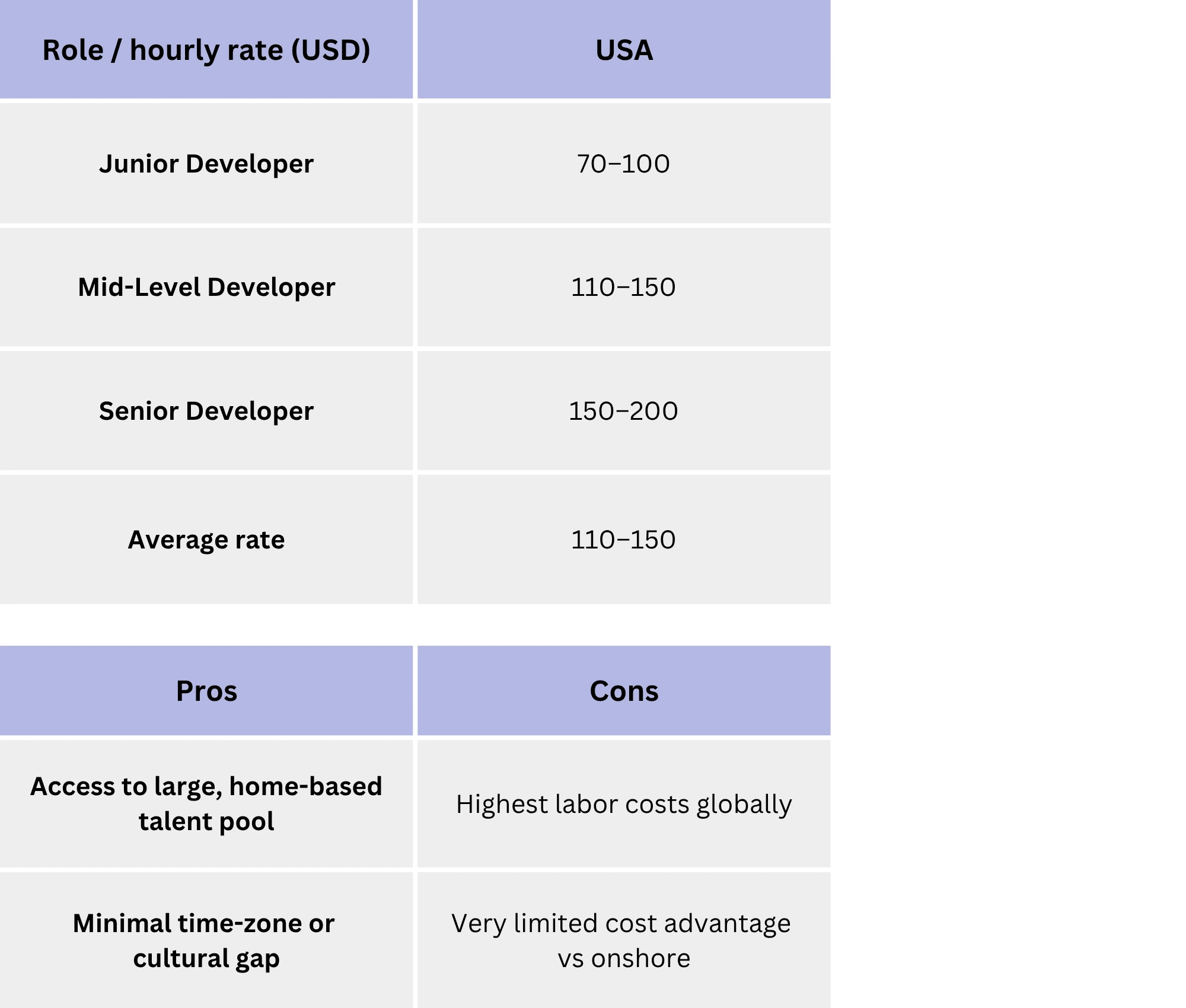
Europe
Europe represents a diverse range of markets - from high-cost hubs like the Netherlands to more cost-efficient ones such as Bulgaria. We highlight both as main reference points.
Average offshore development rates in the Netherlands in 2026
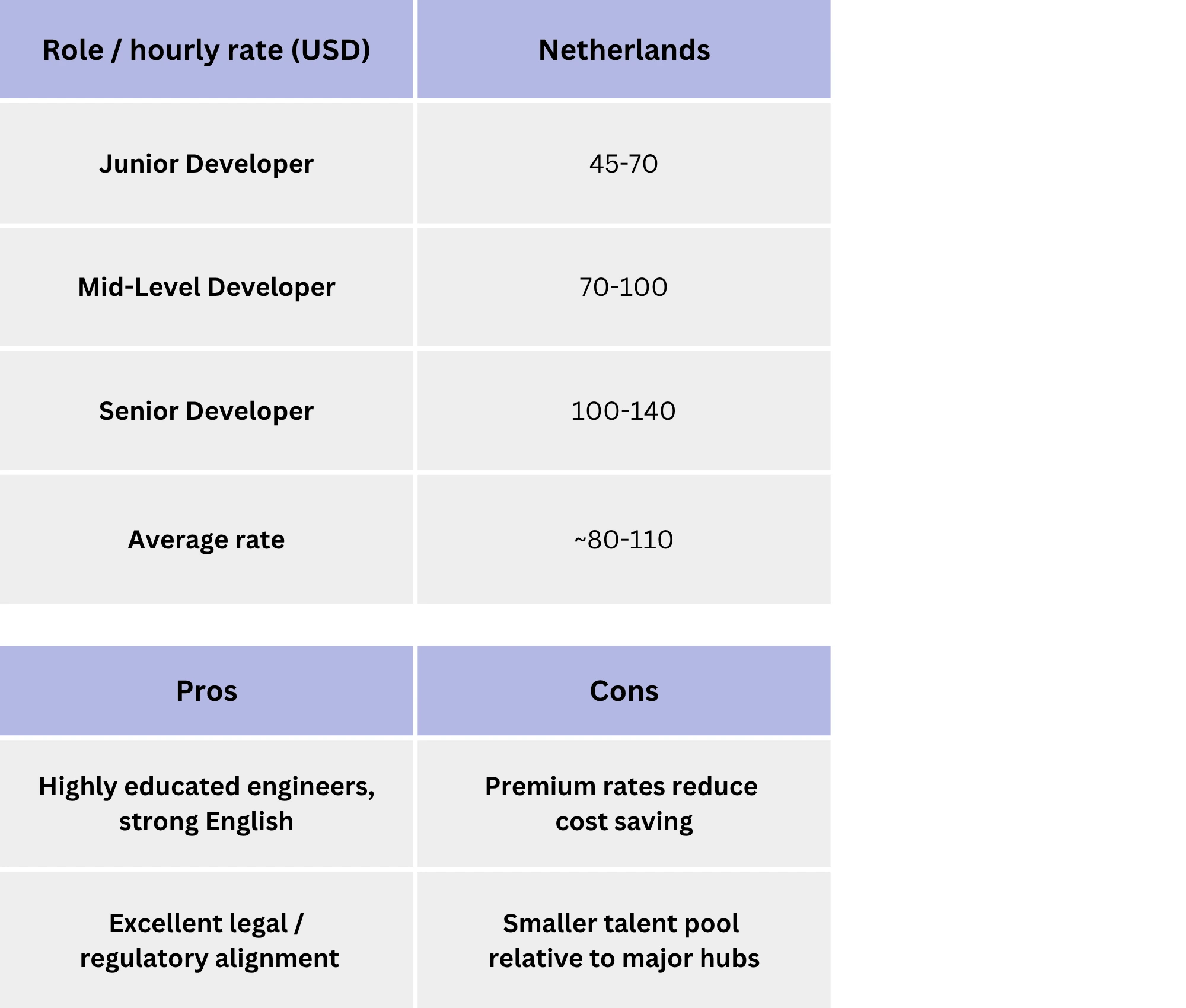
Average offshore development rates in Bulgaria in 2026
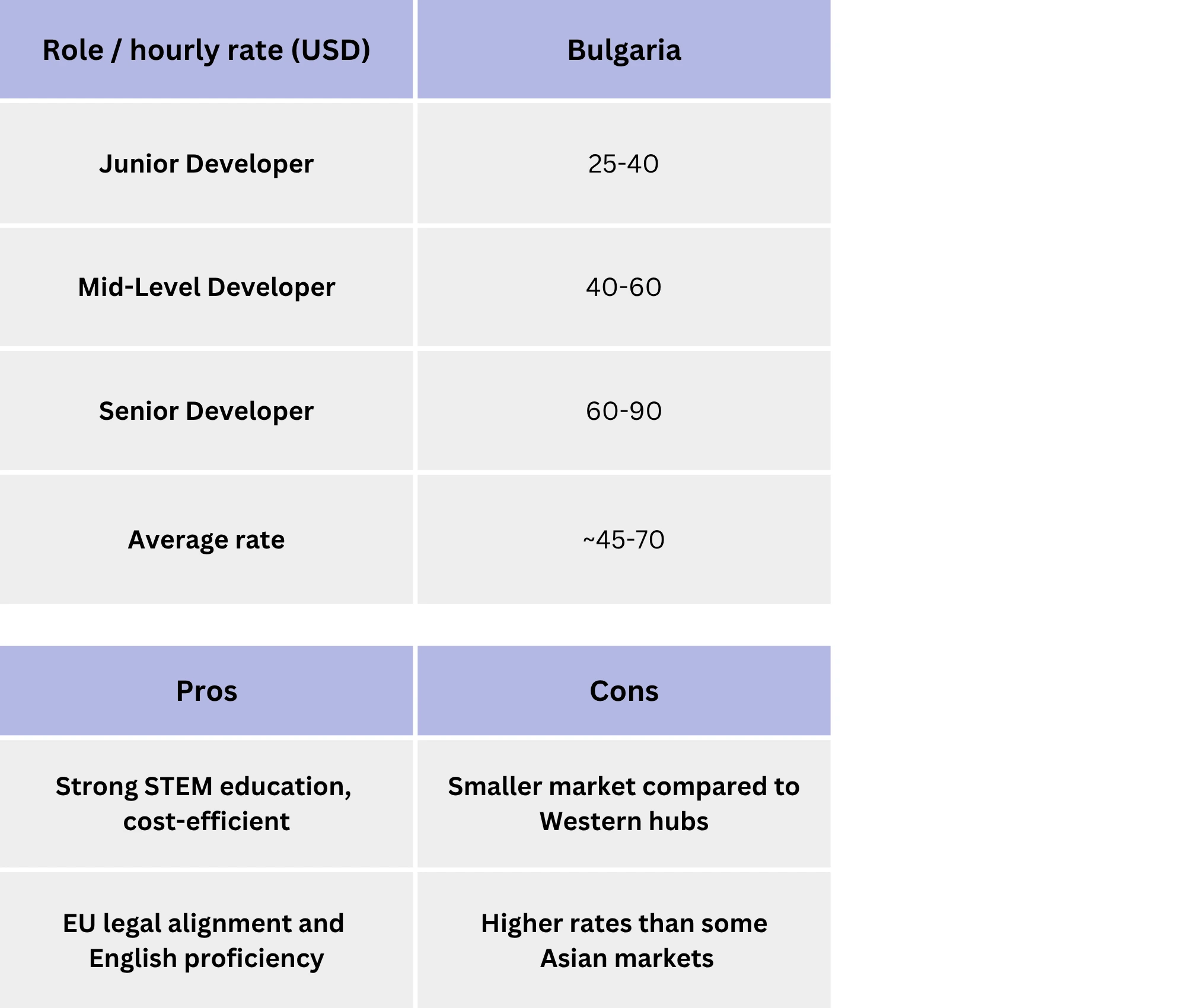
Asia
Asia remains a major offshore destination for cost-sensitive companies, though the rate spread is wide and communication/time-zone management is key.
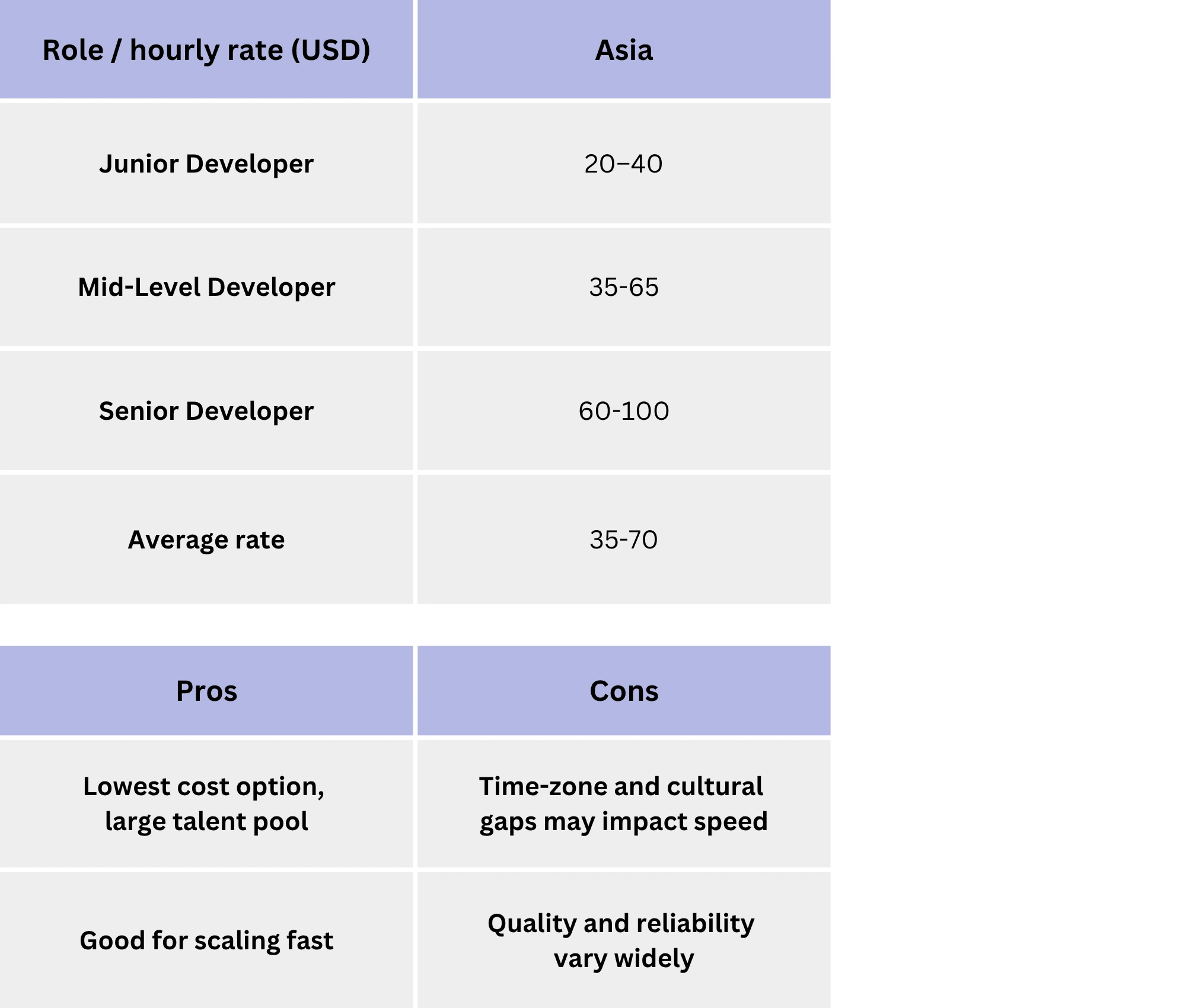
Offshore software development rates: Comparison by region
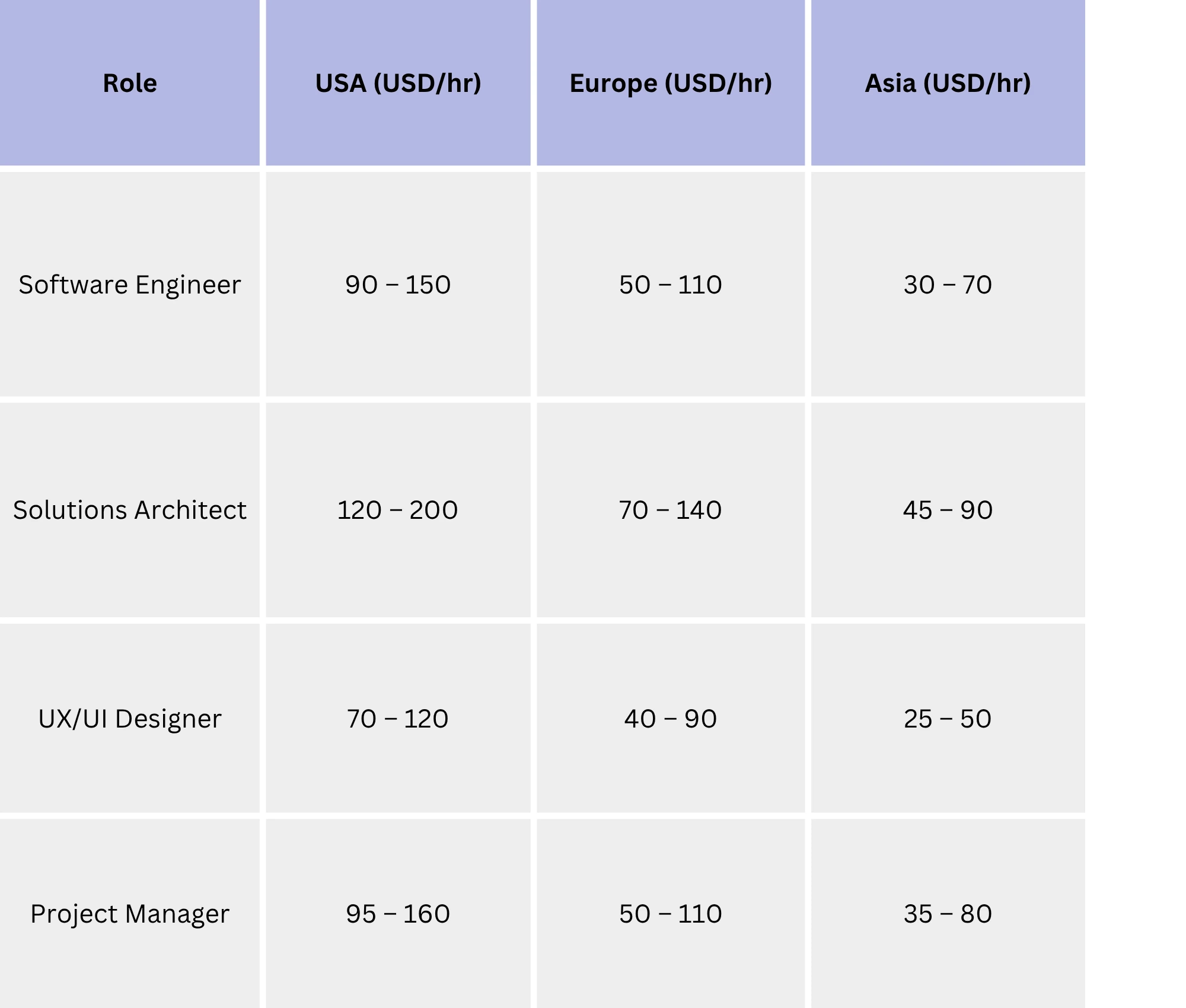
Why do offshore rates vary?
Offshore software development rates are not uniform - they can differ greatly depending on where you're hiring and what you're hiring for. Understanding the reasons behind these variations is essential for evaluating not just the cost, but the value you’re getting for your investment. Below are the key drivers that influence offshore pricing:
- Talent supply and demand
One of the most influential factors is the size and competitiveness of the local talent pool. In countries like India or Ukraine, where there are vast numbers of skilled developers and a long history of serving global clients, supply often outpaces demand. This drives rates down while still maintaining a good level of expertise. In contrast, smaller countries or emerging markets may have fewer qualified professionals. When demand for their services grows, especially in specialized fields, prices naturally go up due to limited availability.
- Living costs and local wages
The general cost of living in a region directly affects the salary expectations of software developers. Developers in countries with high living expenses (such as Switzerland or Singapore) command significantly higher wages compared to those in countries where the cost of living is lower. These local economic conditions set the baseline for what offshore teams charge for their services.
- Complexity of technologies involved
Not all developers are equal in terms of skill set or specialization. If your project involves cutting-edge or niche technologies, like artificial intelligence, blockchain, or cloud-native architecture, you’ll likely need experts with deeper, more specialized knowledge. These professionals are in higher demand globally and typically charge premium rates, regardless of their location.
- Communication and time-zone impact
The farther your offshore team is, in terms of time zones, language fluency, and cultural alignment, the more effort may be required to manage the collaboration effectively. This might mean longer onboarding periods, more meetings, or extra management hours. These overheads can translate into indirect costs that influence the total cost of the engagement, even if the hourly rate seems low.
- Regulatory and infrastructure maturity
Countries with well-developed legal systems, reliable power and internet infrastructure, and strong data security regulations tend to offer more stable and professional service environments. While hourly rates may be slightly higher in these regions, the tradeoff is often fewer disruptions, greater accountability, and reduced risk of legal or compliance issues. This makes them a safer long-term investment.
By understanding these core factors, you’ll be better equipped to look beyond the hourly number and evaluate what you’re really getting for your money. The goal isn’t just to minimize costs, but to maximize value by finding the right balance between price, quality, and reliability.
Choosing the right offshore region for your business
Selecting the right offshore region is a strategic decision that depends on more than just pricing. It requires aligning your business needs with what each region can offer in terms of talent, infrastructure, and compatibility. To help guide this decision, consider the following key questions:
- Do you prioritize the lowest possible cost, or is manageability and quality more important?
Some regions may offer very low hourly rates, but that doesn’t always translate to the best results. Think about whether your priority is purely cost-saving, or if you're willing to invest a bit more for smoother collaboration, better quality control, and more predictable outcomes.
- What time-zone overlap do you need for meetings and real-time collaboration?
Time-zone differences can impact daily workflows, especially if your team requires regular communication or agile development cycles. Consider how many hours of overlap are ideal for your team and choose a region that aligns with that. For example, Latin America may be better suited for U.S. companies needing real-time communication, while Eastern Europe works well for Western Europe.
- How mature must the talent pool be—are you looking for junior developers or senior experts in specific technologies?
Some regions specialize in high-volume, generalist development, while others are known for deep technical expertise in emerging fields like AI, cybersecurity, or cloud architecture. Define your expectations around experience level and tech stack early so you can assess whether a region’s talent pool meets those needs.
- Can you effectively manage cultural or language differences?
Smooth communication is about more than just speaking the same language. Work styles, business etiquette, and cultural norms can all influence how well your teams collaborate. If you're new to offshore development, working with culturally similar regions—or vendors with strong cross-cultural experience—can make the transition easier.
- Do you require strong data protection or compliance with regulations (e.g., GDPR in Europe)?
Certain industries—like finance, healthcare, or SaaS—must adhere to strict data privacy standards. If your business operates in a regulated sector, look for offshore regions that have robust legal frameworks and are familiar with international compliance standards such as GDPR or HIPAA.
By thoughtfully answering these questions, you’ll be able to narrow down which offshore regions align best with your goals. This clarity will also help you select the right vendor and engagement model, whether it’s a fully managed team, a staff augmentation approach, or a long-term development partnership.
Conclusion
Offshore software development in 2026 offers a smart way to access global talent, speed up delivery, and manage costs, but success depends on strategic choices. It’s not just about finding the lowest hourly rate; it’s about choosing the right region, partner, and engagement model to align with your goals. For instance, the U.S. has top-tier talent but the highest rates. Europe offers a mix - premium hubs like Germany or the Netherlands, and more affordable options like Poland or Romania. In Asia, countries like India, Vietnam, and the Philippines provide the lowest costs and vast talent pools, though they may require more oversight due to time-zone and cultural differences. By considering factors like talent availability, communication, regulations, and project complexity, you can choose an offshore setup that balances cost with value. When approached thoughtfully, offshore development becomes more than a budget fix - it’s a scalable, long-term strategy for growth and innovation.
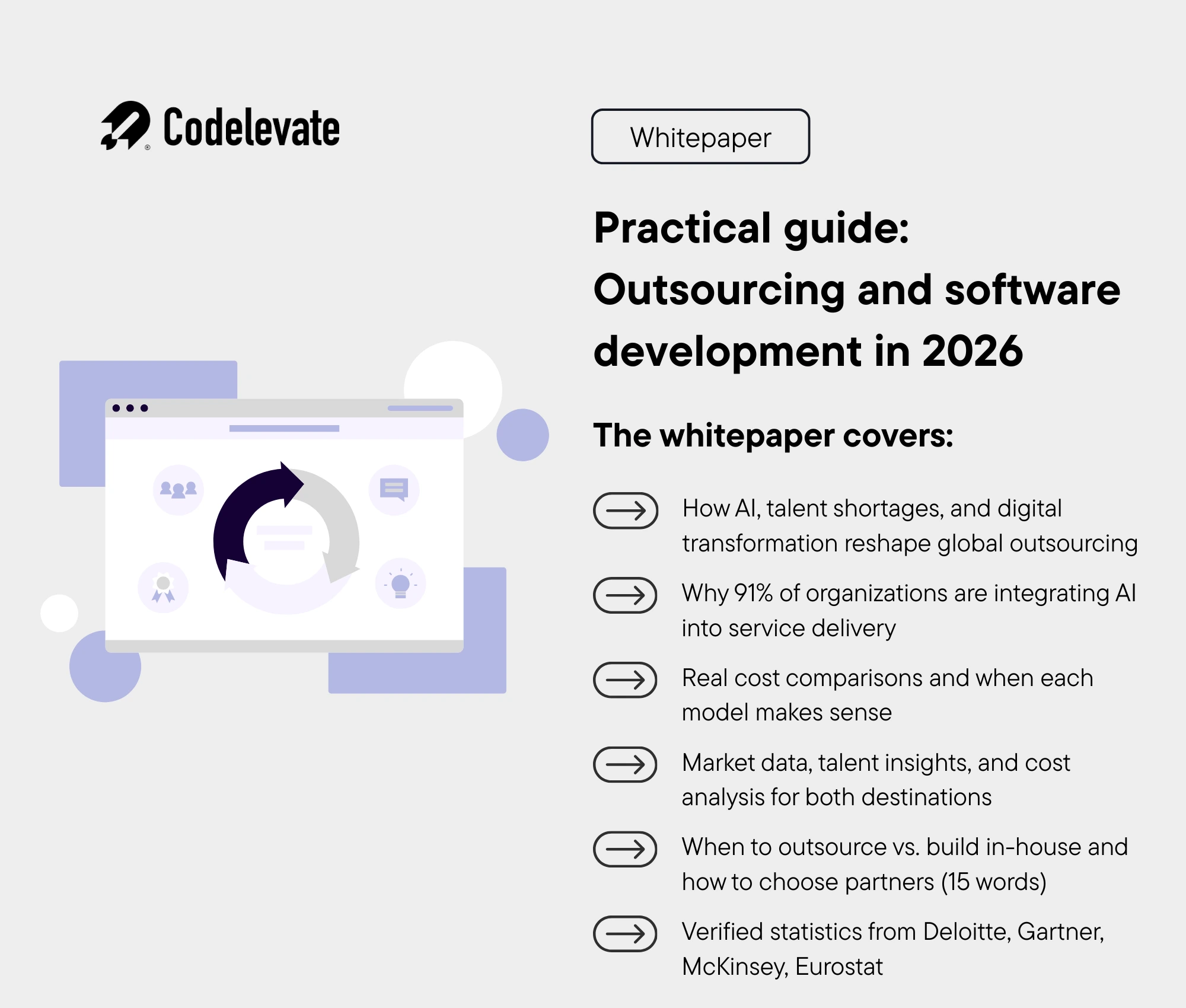

Why Codelevate is your best outsourcing partner
At Codelevate, we’re all about working closely with our clients to create high-quality, scalable solutions that match your business goals and timelines. We keep things simple with a fixed pricing model, so there are no surprise costs or scope creep along the way. With over 120 clients under our belt, we’ve got the experience to manage projects of all sizes. We’re also committed to data privacy and sustainable practices, so you can trust that your project is in good hands. Whether you're a startup or an established enterprise, our team’s expertise in SaaS and AI is always here to help you succeed.





.webp)
.svg)




